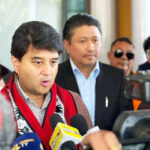With the fast paced developments that have unfolded in recent days in the Naga political landscape, it will not be unfounded to believe that there certainly is going to be a ‘solution’ to the Naga political problem in one form or the other, sooner than later. The ruling BJP would definitely want to own the bragging rights now that the elections to the Nagaland legislative assembly is just around the corner. They will want to prove that their ‘election for solution’ slogan of 2018 has been fulfilled. Prime Minister Modi’s proclamation to the world that the Naga political issue has been resolved will come back to haunt the BJP if something is not worked out in the few months’ time that is left before the elections. It remains to be seen what kind of a ‘solution’ will be worked out but it is clear that it will not be at the cost of India’s national interests. Further, the fact that the Union Home Minister has entrusted the Nagaland state government’s Core Committee on Naga Political Issue to convince the NSCN(IM) to ink the final solution shows to tell that the much anticipated ‘solution’ is not going to be something that is ‘out of the box’. It remains to be seen what the BJP national president JP Nadda will say on the issue during his visit to the state but it is amply clear that the BJP government wants to solve the problem but on its own terms. As observed in this column earlier, solving the Naga political problem is more complex for India than it is for the Naga people.
Meanwhile, in a heartening development, the NSCN (IM) and the NNPGs have jointly signed their ‘September Joint Accordant’ facilitated by the Forum for Naga Reconciliation on Wednesday. This new agreement also avowed to honor the ‘Covenant of Reconciliation’ signed on June 13, 2009 in letter and in spirit. This proves that the Naga political groups are aware of their differences and are willing to work together despite the differences. This is the prayer of the Naga people answered. There will be some detractors even among the Naga people but this Accordant will be read in history textbooks if only the signatories would uphold it. One of the fundamental impediments to molding a unified Naga national group, as evidenced by history, is the lingering distrust among the Naga political groups despite working for the same cause. The FNR is appreciated for exploring and taking up the challenging task of achieving historical reconciliation between Naga political groups divided by deep-seated historical grievances and of breaking through the long-standing impasse in resolving a number of protracted conflicts within the Naga family. Hopefully, this time, the pernicious influence of the underlying mistrust among the Naga groups will be overcome.
The Naga people are fatigued by the conflict and almost disoriented by the never-ending talks for the elusive ‘solution’ and it is felt that the Naga political groups must take into cognizance the mood of the people for whom they proclaim to work for.



